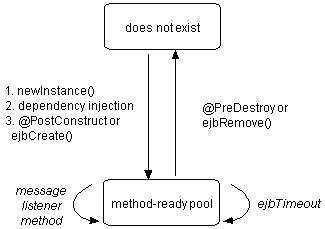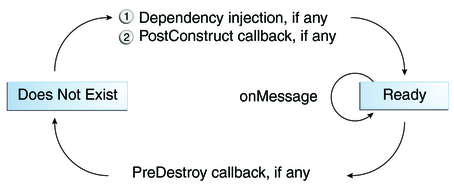Message Beans have guaranteed delivery once a message is on a queue Assuming the queue is persistent it is persisted and even in case of a crash upon startup the MessageBean will process it. A message driven bean is a type of enterprise bean which is invoked by EJB container when it receives a message from queue or topic.

Message Driven Bean Javatpoint
Transactions with Spring and JPA.

. Session beans allow you to send JMS messages and to receive them synchronously but not asynchronously. Note that each endpoint that is concurrently processing a message request adds at least two times the message size to the server JVM heap and can add more especially if a two-phase. Description of a Message-driven Bean A Message-driven Bean is an EJB component that can be considered as a JMS MessageListener ie processing JMS messages asynchronously.
A message-driven bean containing a job is called a JobBean. As a rule of thumb you should use MDBs only if you require asynchronous processing loose-coupling and reliability. If you use WebSphere MQ messaging provider activation specifications in either of the following circumstances.
When a new message arrives the enterprise JavaBeans container calls the message-driven beans onMessage method to process the message. To deliver messages to message-driven beans inside a transaction with any transport type. By only introducing the library or the module to the classpath Spring could automatically scan it and create the necessary object and Autowrired it.
To avoid tying up server resources do not to use blocking synchronous receives in a server-side component. Just turn auto clutch off and transmission to realistic. The most benefit of using a framework like Spring is auto-configuration.
To receive messages asynchronously use a message-driven bean. A JobBean is executed when it receives a Java Messaging Service JMS message from the scheduler runtime service. Jobs are implemented on the basis of message-driven beans.
As always the code is over on GitHub. To receive messages asynchronously use a message-driven bean. As mentioned by others thats the behavior of clutch assist andor arcade automatic.
Debugging these JPA issues in production is. When to Use Message-Driven Beans Session beans and entity beans allow you to send JMS messages and to receive them synchronously but not asynchronously. It is associated with a JMS destination ie a Queue for.
In the case of asynchronous Session Beans in case of a crash you have lost your message unless you handle this yourself. Briefly explain any seven JSP implicit objects. It typically goes about as a Java Message Services message audience which is like an occasion audience aside from that it gets.
In general JMS messages should not be sent or received synchronously. Therefore MDBs allow us to decouple our applications into smaller services with localized responsibilities allowing a much more modular and incremental system that can recover from system failures. A message-driven beans instances retain no data or conversational state for a specific client.
In either case a message-driven bean does not receive a transaction context from the client that sends a message. Student- ID student-name program semester student address using JDBC. Component is an annotation that annotates a classIt tells Spring to use this class to create a bean if there is somewhere else depend on this.
As with other EJB types message-driven beans can demarcate transaction boundaries either on their own using bean-managed transactions or by having the WebLogic Server container manage transactions container-managed transactions. What is the purpose of message-driven beans and define its structure. As for your wheel selection the link goes to a g920.
In cluster environment the JMS is responsible. Generally speaking the g29 is considered the better alternative. Messaging and message-driven beans are powerful concepts but they are not right for every use-case.
The message is cast as a JMS message which is handled based on. Message Driven Beans allow simple creation of a queue based application. To demonstrate use of message driven bean we will make use of EJB-persistence chapter and we need to do the following tasks.
Message driven beans are the light weight components used for communication via messages eg email or IM messages. Explain various circumstances under which a message driven bean should be used. Message driven bean is a stateless bean and is used to do task asynchronously.
Explain the various circumstances under which a message-driven bean should be used. Session beans allow you to send JMS messages and to receive them synchronously but not asynchronously. Message-driven beans are used in asynchronous communication between enterprise application components.
What makes message driven beans different from session beans. When you deploy a message-driven bean that processes messages concurrently estimate the potential consumption of the application server memory by concurrent endpoints. To avoid tying up server resources you may prefer not to use blocking synchronous receives in a server-side component.
A message-driven bean is an endeavor bean that permits Java Enterproses Entity applications to process messages non-concurrently. The and part in. Code that works in our local environment or in staging performs very poorly or even flat out fails when thrown against real-scale databases in production environments.
The Message-driven bean can only use the Migratable Service when they are on clustered servers At this time the Migratable Service cannot span multiple clusters. All instances of a message-driven bean are equivalent allowing the EJB container to assign a message to any message-driven bean instance. A Message-Driven Bean Example Introduction.
The container can pool these instances to allow streams of. If WebLogic Server does not migrate the message-driven bean along with the JMS Server to an available server in the cluster the JMS destination will be flooded with messages. It implements the onMessagejavaxjmsMessage method defined in the javaxjmsMessageListener interface.
A message is processed as follows. Assume that the student table is created in database. In several respects a message-driven bean resembles a stateless session bean.
You are using a transport mode of client or bindings then client the client leg is used and a transaction does not exist. JPA can behave very differently depending on the exact circumstances under which it is used. To receive messages asynchronously a Message-driven bean is used.
Write a code in JSP to insert records in a student table with fields. The execution of JobBeans is handled by the EJB container.


0 Comments